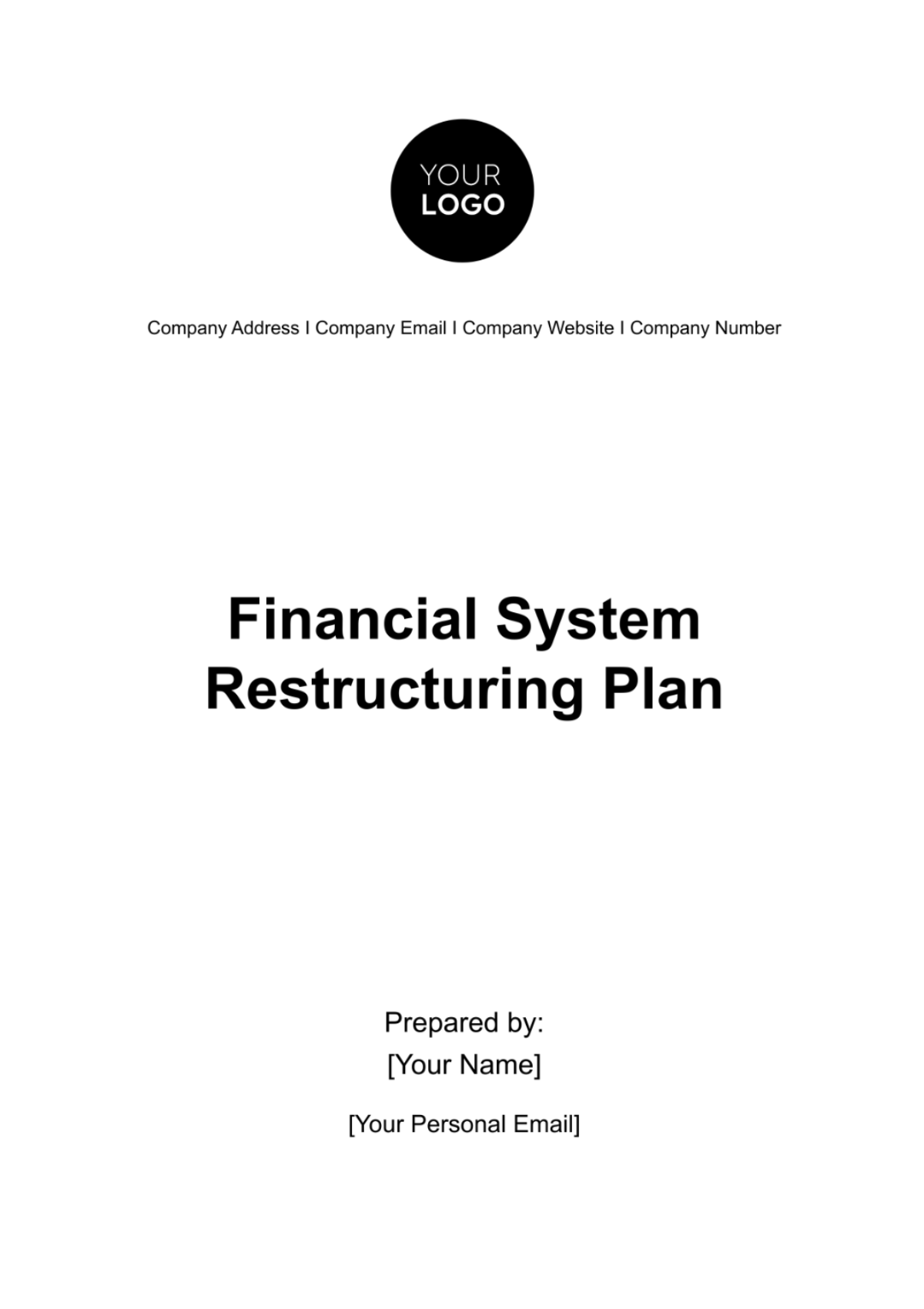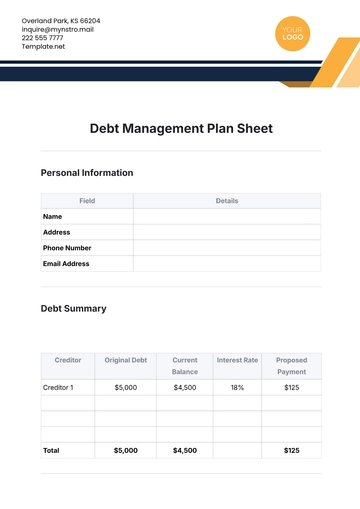Free Financial System Restructuring Plan

Executive Summary
A. Overview
[Your Company Name] has undertaken a comprehensive Financial System Restructuring Plan to enhance the efficiency and sustainability of our financial operations. The primary goal is to ensure long-term financial stability, improve profitability, and mitigate potential risks. This plan encompasses a strategic approach to restructuring, addressing both short-term challenges and fostering sustainable growth.
B. Objectives
The key objectives of this restructuring plan include:
Enhancing liquidity and solvency.
Optimizing operational efficiency.
Strengthening risk management practices.
Improving overall financial performance.
C. Anticipated Outcomes
Upon successful implementation of the restructuring plan, [Your Company Name] expects to achieve:
Improved financial health indicators.
Increased investor confidence.
Enhanced competitive positioning in the market.
Introduction
A. Background
[Your Company Name] operates in a dynamic economic environment, and to thrive, a resilient and adaptive financial system is imperative. The decision to undertake this restructuring plan stems from a comprehensive analysis of the current financial landscape, identifying areas for improvement and growth.
B. Purpose of the Plan
The purpose of the Financial System Restructuring Plan is to:
Position [Your Company Name] for sustained success in a rapidly changing market.
Ensure alignment with industry best practices and regulatory requirements.
Optimize resource allocation and enhance overall financial performance.
C. Scope
The restructuring plan will encompass all aspects of [Your Company Name]'s financial operations, including but not limited to:
Financial risk assessment and mitigation strategies.
Operational efficiency improvements.
Comprehensive financial statement analysis and projections.
D. Stakeholder Involvement
The restructuring plan is a collaborative effort, involving input from internal and external stakeholders. Regular communication and feedback mechanisms will be established to ensure transparency and inclusivity throughout the restructuring process.
Current Financial System Assessment
A. Financial Health Analysis
To gauge the current financial health of [Your Company Name], an in-depth analysis was conducted covering key financial indicators:
Liquidity: As of [July 07, 2050], our current liquidity ratio stands at [$1.5 million], indicating a Stable level.
Solvency: The debt-to-equity ratio is [0.8:1], reflecting a Healthy solvency position.
Profitability: Net profit margins over the last fiscal year were [12%], signaling Stability in profitability.
B. Risk Assessment
An extensive risk assessment identified potential threats to our financial system:
Market Risk: With specific market factors, there is a [10%] risk of negative impact.
Credit Risk: Our exposure to credit factors poses a moderate risk.
Operational Risk: Identified operational risks present a Moderate level of risk to our financial stability.
Restructuring Objectives
A. Short-Term Objectives
In the short term, the restructuring plan aims to address immediate challenges and set the foundation for long-term success:
Enhance Liquidity: Implement measures to improve short-term liquidity, targeting a [15%] increase.
Operational Streamlining: Identify and eliminate inefficiencies to achieve a [10%] reduction in operating costs.
Risk Mitigation: Develop and implement strategies to reduce exposure to identified risks by [20%].
B. Long-Term Objectives
Looking ahead, the restructuring plan sets ambitious long-term goals to position [Your Company Name] as a financial industry leader:
Sustainable Growth: Achieve an annual revenue growth rate of [8%] over the next [5] years.
Robust Risk Management: Establish a comprehensive risk management framework, reducing overall risk exposure by [15%].
Industry Leadership: Attain a [12%] market share within the industry, solidifying our position as a key player.
Stakeholder Analysis
A. Internal Stakeholders
Stakeholder Group | Impact of Restructuring | Communication Strategy |
|---|---|---|
Employees | The restructuring may lead to changes in roles and responsibilities. | Clear communication channels will be established to address concerns and provide updates regularly. Regular town hall meetings, Q&A sessions, and dedicated communication channels will be initiated. |
B. External Stakeholders
Stakeholder Group | Impact of Restructuring | Communication Strategy |
|---|---|---|
Customers | Minimal disruption to services; potential improvements in product offerings. | Minimal disruption to services; potential improvements in product offerings. Proactive communication through multiple channels, including emails, newsletters, and social media. A customer hotline will be established for queries and concerns. |
Restructuring Strategy
A. Strategic Framework
The restructuring strategy involves a multi-faceted approach to address financial and operational aspects:
Financial Optimization: Implement cost-cutting measures, renegotiate contracts, and explore new revenue streams to enhance financial stability.
Operational Efficiency: Conduct a thorough review of processes, streamline workflows, and invest in technology to improve overall efficiency.
Risk Management: Develop and implement robust risk mitigation strategies, including diversification of investments and comprehensive insurance coverage.
B. Implementation Plan
Task | Responsible Party | Timeline | Progress |
|---|---|---|---|
Conduct Financial Health Assessment | CFO and Financial Team | [April 23, 2050 - May 20, 2050] | Completed |
Financial Projections
A. Projected Financial Statements
The following table outlines the projected financial statements for [Your Company Name] over the next five years:
Financial Projections Analysis:
The projections indicate a steady increase in revenue, reflecting the positive impact of the restructuring plan on [Your Company Name]'s financial performance. The controlled growth in expenses ensures a sustained profit margin, fostering financial stability and resilience.
Risk Mitigation Plan
A. Identification of Risks
A comprehensive risk assessment has identified several key risks associated with the restructuring plan:
Market Risk: The potential for economic downturns affecting consumer spending.
Credit Risk: Default on loans or payment delays from key clients.
Operational Risk: Disruptions in operations due to unforeseen events such as natural disasters or cyber-attacks.
B. Mitigation Strategies
To mitigate these risks, the following strategies will be implemented:
Market Risk Mitigation: Diversify product offerings and expand into new markets to reduce reliance on a specific segment.
Credit Risk Mitigation: Strengthen credit evaluation processes and establish contingency funds to manage potential defaults.
Operational Risk Mitigation: Implement robust business continuity plans and invest in cybersecurity measures to safeguard against operational disruptions.
Table: Implementation of Risk Mitigation Strategies
Risk Type | Mitigation Strategy | Responsible Party | Timeline | Progress |
|---|---|---|---|---|
Market Risk | Diversification of Product Offerings | Strategy Team | [May 25, 2050 - June 25, 2050] | In Progress |
Risk Exposure Reduction:
Communication Plan
A. Internal Communication
Internal communication during the restructuring process is crucial for maintaining employee morale and ensuring a smooth transition. The following strategies will be employed:
Regular Updates: Monthly town hall meetings will be conducted to update employees on the progress of the restructuring plan, address concerns, and gather feedback.
Open Communication Channels: Establish a dedicated communication platform where employees can ask questions, share suggestions, and receive real-time updates.
Training Sessions: Conduct training sessions to equip employees with the necessary skills and knowledge to adapt to new processes.
B. External Communication
Maintaining transparent and effective communication with external stakeholders is essential for building trust. The plan includes:
Timely Updates: Quarterly newsletters and press releases will be issued to keep customers, investors, and regulatory bodies informed about the progress of the restructuring plan.
Dedicated Hotline: A customer hotline will be established to address inquiries and concerns promptly, fostering a sense of trust and reliability.
Investor Conferences: Regular investor conferences will be organized to provide detailed insights into the restructuring plan and its impact on the company's financial outlook.
Monitoring and Evaluation
A. Key Performance Indicators (KPIs)
To monitor the progress and success of the restructuring plan, the following key performance indicators (KPIs) will be tracked:
Financial KPIs: Revenue growth rate, profit margins, and return on investment (ROI).
Operational KPIs: Efficiency ratios, cost reduction percentages, and process improvement metrics.
Risk Management KPIs: Reduction in overall risk exposure and successful implementation of risk mitigation strategies.
B. Evaluation Criteria
The effectiveness of the restructuring efforts will be evaluated based on:
Financial Performance: Comparing actual financial results with projected figures.
Stakeholder Satisfaction: Gathering feedback from employees, customers, investors, and regulatory bodies.
Adherence to Timelines: Assessing whether the restructuring plan is being implemented within the planned timelines.
Table: Monitoring and Evaluation Progress
KPI | Target | Current Status | Action Plan |
|---|---|---|---|
Revenue Growth Rate | [8%] annually | [5%] | Implement new marketing strategies to boost revenue. |
Conclusion
The Financial System Restructuring Plan presented by [Your Company Name] outlines a strategic roadmap to enhance our financial resilience, operational efficiency, and overall competitiveness. As we embark on this transformative journey, we are committed to achieving the outlined objectives and ensuring the sustained success of our organization.
The restructuring plan addresses current challenges through a combination of financial optimization, operational streamlining, and robust risk management strategies. Through transparent and proactive communication, both internally and externally, we aim to build trust among stakeholders and keep them informed about the progress and benefits of the restructuring efforts.
- 100% Customizable, free editor
- Access 1 Million+ Templates, photo’s & graphics
- Download or share as a template
- Click and replace photos, graphics, text, backgrounds
- Resize, crop, AI write & more
- Access advanced editor
Effortlessly navigate financial system restructuring with our Template.net Financial System Restructuring Plan Template. This editable and customizable tool empowers you to adapt and refine your restructuring strategy seamlessly. Utilize our Ai Editor Tool to make personalized adjustments, ensuring a tailored approach to your financial system transformation. Elevate your restructuring process with this user-friendly and versatile template.
You may also like
- Finance Plan
- Construction Plan
- Sales Plan
- Development Plan
- Career Plan
- Budget Plan
- HR Plan
- Education Plan
- Transition Plan
- Work Plan
- Training Plan
- Communication Plan
- Operation Plan
- Health And Safety Plan
- Strategy Plan
- Professional Development Plan
- Advertising Plan
- Risk Management Plan
- Restaurant Plan
- School Plan
- Nursing Home Patient Care Plan
- Nursing Care Plan
- Plan Event
- Startup Plan
- Social Media Plan
- Staffing Plan
- Annual Plan
- Content Plan
- Payment Plan
- Implementation Plan
- Hotel Plan
- Workout Plan
- Accounting Plan
- Campaign Plan
- Essay Plan
- 30 60 90 Day Plan
- Research Plan
- Recruitment Plan
- 90 Day Plan
- Quarterly Plan
- Emergency Plan
- 5 Year Plan
- Gym Plan
- Personal Plan
- IT and Software Plan
- Treatment Plan
- Real Estate Plan
- Law Firm Plan
- Healthcare Plan
- Improvement Plan
- Media Plan
- 5 Year Business Plan
- Learning Plan
- Marketing Campaign Plan
- Travel Agency Plan
- Cleaning Services Plan
- Interior Design Plan
- Performance Plan
- PR Plan
- Birth Plan
- Life Plan
- SEO Plan
- Disaster Recovery Plan
- Continuity Plan
- Launch Plan
- Legal Plan
- Behavior Plan
- Performance Improvement Plan
- Salon Plan
- Security Plan
- Security Management Plan
- Employee Development Plan
- Quality Plan
- Service Improvement Plan
- Growth Plan
- Incident Response Plan
- Basketball Plan
- Emergency Action Plan
- Product Launch Plan
- Spa Plan
- Employee Training Plan
- Data Analysis Plan
- Employee Action Plan
- Territory Plan
- Audit Plan
- Classroom Plan
- Activity Plan
- Parenting Plan
- Care Plan
- Project Execution Plan
- Exercise Plan
- Internship Plan
- Software Development Plan
- Continuous Improvement Plan
- Leave Plan
- 90 Day Sales Plan
- Advertising Agency Plan
- Employee Transition Plan
- Smart Action Plan
- Workplace Safety Plan
- Behavior Change Plan
- Contingency Plan
- Continuity of Operations Plan
- Health Plan
- Quality Control Plan
- Self Plan
- Sports Development Plan
- Change Management Plan
- Ecommerce Plan
- Personal Financial Plan
- Process Improvement Plan
- 30-60-90 Day Sales Plan
- Crisis Management Plan
- Engagement Plan
- Execution Plan
- Pandemic Plan
- Quality Assurance Plan
- Service Continuity Plan
- Agile Project Plan
- Fundraising Plan
- Job Transition Plan
- Asset Maintenance Plan
- Maintenance Plan
- Software Test Plan
- Staff Training and Development Plan
- 3 Year Plan
- Brand Activation Plan
- Release Plan
- Resource Plan
- Risk Mitigation Plan
- Teacher Plan
- 30 60 90 Day Plan for New Manager
- Food Safety Plan
- Food Truck Plan
- Hiring Plan
- Quality Management Plan
- Wellness Plan
- Behavior Intervention Plan
- Bonus Plan
- Investment Plan
- Maternity Leave Plan
- Pandemic Response Plan
- Succession Planning
- Coaching Plan
- Configuration Management Plan
- Remote Work Plan
- Self Care Plan
- Teaching Plan
- 100-Day Plan
- HACCP Plan
- Student Plan
- Sustainability Plan
- 30 60 90 Day Plan for Interview
- Access Plan
- Site Specific Safety Plan





























